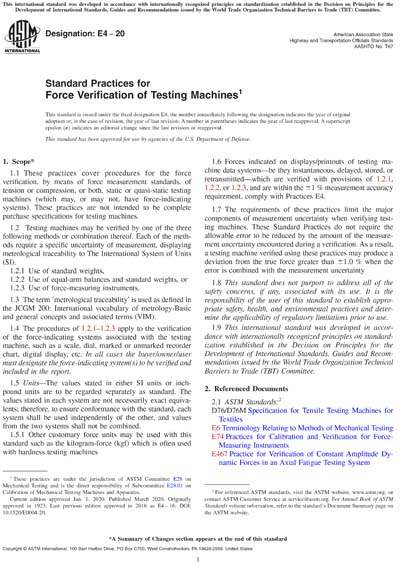Historical
ASTM E4-20
Standard Practices for Force Verification of Testing Machines
1.1 These practices cover procedures for the force verification, by means of force measurement standards, of tension or compression, or both, static or quasi-static testing machines (which may, or may not, have force-indicating systems). These practices are not intended to be complete purchase specifications for testing machines.
1.2 Testing machines may be verified by one of the three following methods or combination thereof. Each of the methods require a specific uncertainty of measurement, displaying metrological traceability to The International System of Units (SI).
1.2.1 Use of standard weights,
1.2.2 Use of equal-arm balances and standard weights, or
1.2.3 Use of force-measuring instruments.
1.3 The term ’metrological traceability’ is used as defined in the JCGM 200: International vocabulary of metrology-Basic and general concepts and associated terms (VIM).
1.4 The procedures of 1.2.1–1.2.3 apply to the verification of the force-indicating systems associated with the testing machine, such as a scale, dial, marked or unmarked recorder chart, digital display, etc. In all cases the buyer/owner/user must designate the force-indicating system(s) to be verified and included in the report.
1.5 Units—The values stated in either SI units or inch-pound units are to be regarded separately as standard. The values stated in each system are not necessarily exact equivalents; therefore, to ensure conformance with the standard, each system shall be used independently of the other, and values from the two systems shall not be combined.
1.5.1 Other customary force units may be used with this standard such as the kilogram-force (kgf) which is often used with hardness testing machines
1.6 Forces indicated on displays/printouts of testing machine data systems—be they instantaneous, delayed, stored, or retransmitted—which are verified with provisions of 1.2.1, 1.2.2, or 1.2.3, and are within the ±1 % measurement accuracy requirement, comply with Practices E4.
1.7 The requirements of these practices limit the major components of measurement uncertainty when verifying testing machines. These Standard Practices do not require the allowable error to be reduced by the amount of the measurement uncertainty encountered during a verification. As a result, a testing machine verified using these practices may produce a deviation from the true force greater than ±1.0 % when the error is combined with the measurement uncertainty
1.8 This standard does not purport to address all of the safety concerns, if any, associated with its use. It is the responsibility of the user of this standard to establish appropriate safety, health, and environmental practices and determine the applicability of regulatory limitations prior to use.
1.9 This international standard was developed in accordance with internationally recognized principles on standardization established in the Decision on Principles for the Development of International Standards, Guides and Recommendations issued by the World Trade Organization Technical Barriers to Trade (TBT) Committee.
ASTM International [astm]

